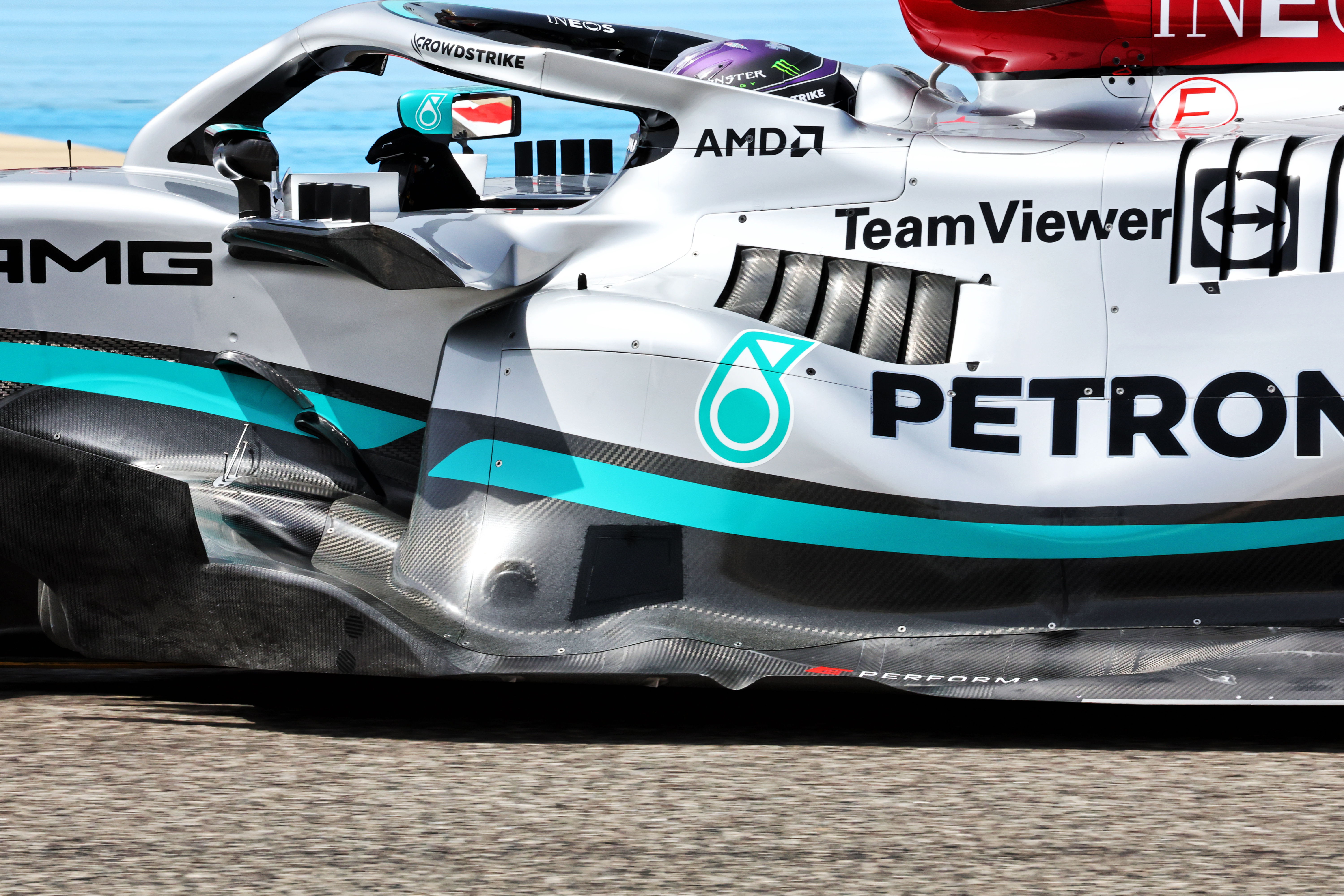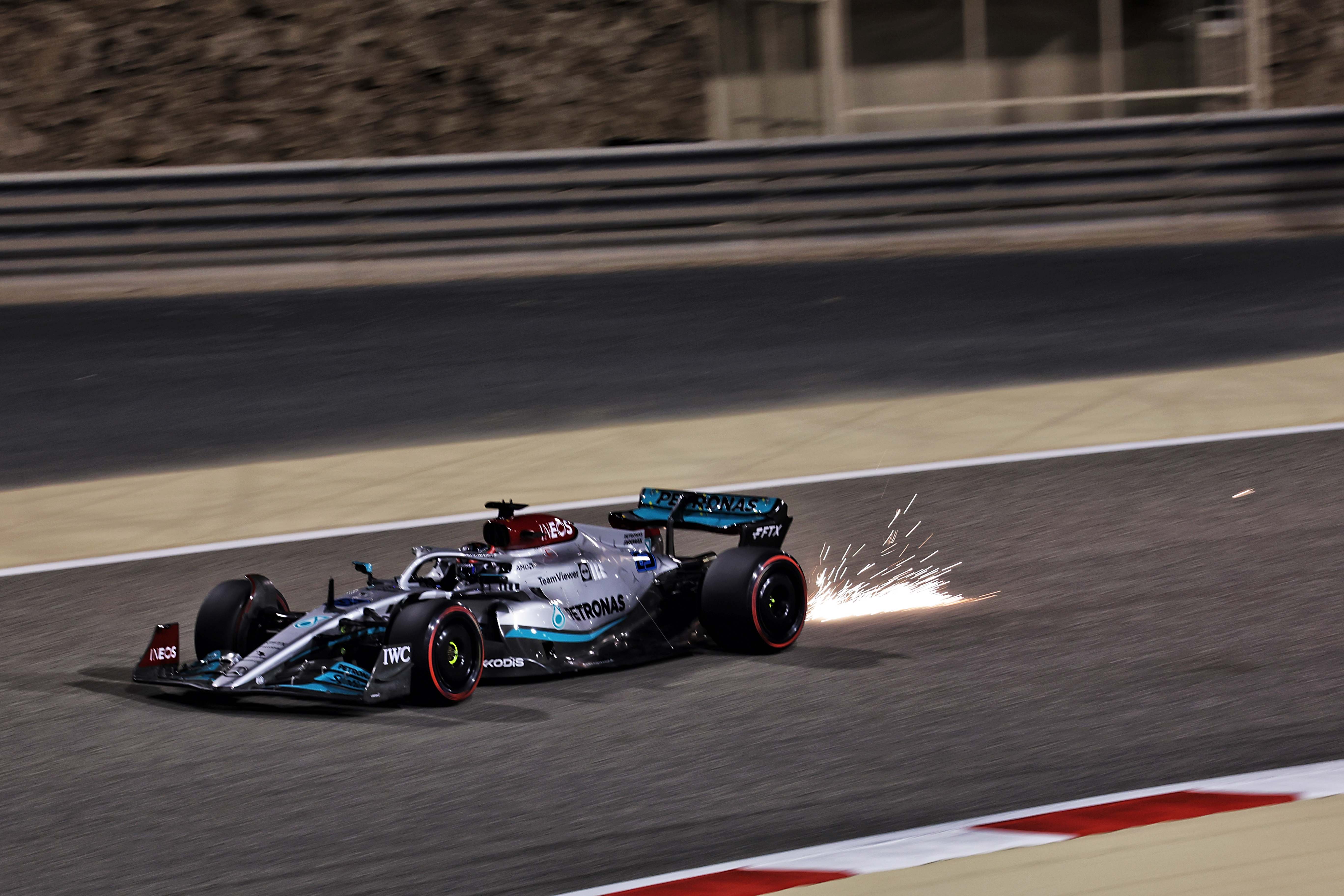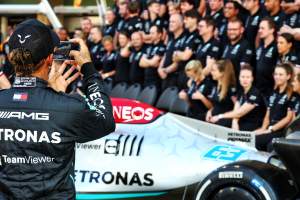Mercedes’ car problems at the start of Formula 1’s new technical regulations in 2022 were so pronounced that early “wobbles” with its revised engine received not nearly as much attention as they might have otherwise.
The weak performance of the Mercedes-engined cars at the Bahrain season opener did prompt some early theories that the High Performance Powertrains division, for so long the benchmark in the V6 turbo-hybrid era, had been overhauled by rival manufacturers.
But there were so many other issues with all the Mercedes teams, and the works cars had such a prominent porpoising issue and performance deficit, that the engine was not really a sustained talking point.
When the real W13 broke cover at the second test in Bahrain its ultra-slim sidepods had quickly become the main technical focus, while the car’s aggressive porpoising limited Mercedes’ performance early on and other weaknesses became apparent as well.
This included poor aerodynamic efficiency that resulted in high drag and made the W13 slow on the straights, which probably helped take attention away from the engine itself.
Mercedes F1 team boss Toto Wolff has now admitted this had “some wobbles” at the start of the year.
In a video released by Mercedes this week, in which Wolff discusses the 2022 season with technical heads Mike Elliott (Mercedes F1 technical director) and Hywel Thomas (Mercedes HPP managing director), Wolff references initial weaknesses of the 2022 engine including “aspects of the deployment or the driveability of the power unit”.
To that, Thomas refers to two “big things” the engine manufacturers had to prioritise – an engine freeze that would lock in the specification and allow for no performance updates for four seasons; and a fuel regulation change to a 10% ethanol mix (up from 5%).
“We had a really big development programme over the whole of last year and through that winter,” Thomas says of the project to get the new engine ready for the freeze.
“And just trying to make sure we landed that was a real big effort, a really, really big effort.”
As for the fuel, Thomas says it was known this would result in a “hit” for Mercedes, which expected others to suffer as well, as the new fuel changed the combustion inside the V6 and resulted in reduced power.
“We just didn’t know where we were going to end up,” says Thomas.
“When we hit the track, I think there was a bit of disappointment and some things that we could certainly put right.

“We knew we couldn’t do it through hardware, which had been our way of developing things for the past however many years.
“So, we had to really go back and reconsider how we were going to develop ourselves out of that position.”
Mercedes’ reworking of its engine for 2022 is easily overlooked given the focus that was on the chassis regulations.
Thomas describes it as a “massive tear-up” at the start of the year that compromised redoing the layout of the exhaust and the cooling systems of the car in the pursuit of aerodynamic gains, which left the front of the engine “completely different”.
The overhaul was so extensive that Mercedes changed more parts of the power unit than in any season since the start of the V6 turbo-hybrid rules in 2014.
When that resulted in a slightly underwhelming set of engine characteristics in Bahrain, the HPP team knew that it had a role to play in Mercedes recovering from being on the back foot – albeit with the freeze meaning only software changes were possible, although the specification of the MGU-K and battery could be amended until September.
“Our part of this is to get some more performance and get some better driveability and we need to add that at the same time the car is being developed and that’s how we will get out of this position,” says Thomas of the early-2022 mentality.
“We all said: ‘How do we do that in this new world?’.
“And that then became the excitement of the season, seeing how we could change the way that we could develop this power unit even though the hardware is frozen to get more performance from it.”
Wolff describes what HPP was able to achieve within these restrictions as a “really important cornerstone” of Mercedes’ work in 2022.
There has long been a heavy emphasis on how the two sides of Mercedes worked together on a joint project, rather than prioritising either chassis or engine at the expense of the other.
Thomas says that it is “becoming clearer and clearer [that] the link between the power unit and the chassis is that you can’t develop them separately”.
“Especially if you want to get the performance from it from this development of non-hardware and the power unit, you have to match the power unit even more beautifully to the chassis,” he says.
“That’s where I would say, especially the second half of the season, is where some of the gains have been coming and that’s a great thing for the future as well.”
Any gains on the engine side were likely masked by the fact Mercedes’ drag levels meant it was often weak at high-speed circuits.
Although there are various factors that play into performance the most telling examples came after the summer break, as the Spa and Monza circuits were obvious outliers in Mercedes’ general trend of improvement.
Wolff says that this was inevitable given “the engine couldn’t pull us through the invisible aerodynamic wall”.
“We were nowhere at the beginning and it looked like a major setback but I guess it was all part of our understanding where the car performed well and how the interaction between drag and power unit performance lay,” Wolff ponders to Thomas.

“And also for you I guess a good step to saying: ‘OK, this is where we believe we perform well, this is where we can help the chassis guys also in terms of increasing speed at the end of the straight when the draggy car was probably shedding too much’.”
To that, Thomas says that HPP resolved to finding “small gains at pretty much every event” without compromising reliability – something that Mercedes did excel at in 2022.
“And that’s what we were seeing,” says Thomas.
“We are in some ways a little bit fortunate that you can see some of those numbers on the dyno, you can do the tests on the dyno, you can see it develops a little bit more energy and you can say: ‘OK, we are taking that to the circuit’ and it’s comforting to be able to watch that and see that working.”
Thomas also adds one overlooked nugget from Mercedes’ porpoising problem in 2022, which is that it put the engines through a brutal physical challenge.
He likens it to what drivers Lewis Hamilton and George Russell were going through when they were suffering the worst of the bouncing in the first third of the season.
“It was becoming very clear that the bottom of the engines were taking a hell of a pounding,” Thomas says.
“When you [Wolff] came up to Brixworth last week you saw some of the parts that were off the race engines and it was quite a surprise to see exactly how hard they were being hit by the ground.
“You know when you see Lewis and George looking a bit uncomfortable getting out of the cars, the power units were doing much the same.”





